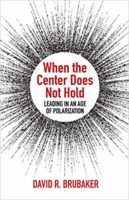
Few individuals are eager to lead in a polarized time. Yet leaders today cannot escape this reality, particularly during an election season. How might congregational leaders navigate the minefields of polarization while safeguarding both their members and their own integrity? The following five suggestions can contribute to successful leadership in polarized contexts.
1. Engage conflict when it emerges not just after it erupts
As conflict emerges in an organization or other system, conflict savvy leaders move toward it when it’s small, rather than avoid it and allow the conflict to grow larger. They do this in two ways. First, they invite disagreement by encouraging members of the system to come to them directly when they have a concern. Second, such leaders take the initiative to approach others, rather than avoid them, when they sense a strained relationship, and encourage others to do the same. These leaders model direct engagement and encourage others to do likewise.
I know a minister in a large congregation who practices this principle. If he hears “through the grapevine” that someone has concerns about his ministry or the direction of the congregation, he invites the person to have coffee or lunch in a neutral location. In the course of the conversation, the minister encourages the person to share their hopes and concerns for the congregation. Opening the door in this way generally releases the concerns in a context where both parties can have a relaxed conversation. Such direct engagement tends to defuse resentment that otherwise might fester and grow.
2. Learn to manage polarities not just resolve conflicts
When a system polarizes, it’s often because the two ends of the spectrum are unable to hold together competing truths or realities. A classic example is the ongoing battle between those who advocate for individual freedom and those who call for community responsibility. These are essentially expressions of the fundamental human needs for both autonomy and affiliation. As consultant and author Barry Johnson suggests, the challenge is not to “resolve the conflict” between two perspectives but to “manage the polarities” that exist within the system.
In my experience, the group that is often best able to live with polarities lies in the critical middle—those individuals in the system who embrace both ends of this artificial dichotomy and are able to receive the truth that each end of the spectrum is advancing. Even in a highly polarized environment, there will be a significant-sized group in the middle. The challenge for leaders is to provide mechanisms for others in the organization to also hear their voices.
3. Remember that as goes the leadership so goes the organization
After more than three decades of consulting with congregations and other religious organizations, I can now predict, with about 90 percent accuracy, which systems will split and which will stay together when confronted with high-level conflict. If those in leadership—both formal and informal—are able to remain in a respectful coexistence, the likelihood of a genuine schism is remarkably low. However, if the leadership group itself polarizes and then splits, the system will almost always do likewise. A house divided against itself cannot stand—and particularly when the “parental” figures model toxic conflict behaviors.
Three of the most destructive conflict behaviors are avoidance, belligerence, and contempt. While temporary withdrawal from a conflict situation can be constructive, chronic avoidance generally leads to relational deterioration. Belligerence from one party tends to escalate conflict and to invite hostility from the other party in return. And contempt may be the most destructive conflict behavior, whether in a marriage or in a work relationship. By contrast, the three most constructive conflict behaviors are the opposite of toxic behaviors. Rather than avoidance, belligerence, and contempt, they are engagement, openness, and respect. When we choose to engage an adversary with openness and respect, we can transform the relationship.
4. Speak your truth
As Speed Leas observed, leaders who decline to self-define can be as frustrating to followers as autocratic leaders. This doesn’t mean that leaders must speak out on every controversial issue, as every wise leader must choose their battles. But it does suggest that effective leadership in a polarized environment will sometimes require a leader to take a stand. This is when moral clarity, informed by one’s core values, becomes the North Star for leaders, guiding them to a principled, rather than a reactive, stance.
Nelson Mandela is often described as an exemplar of moral clarity, both in his unflinching opposition to apartheid in South Africa and in his unwavering commitment to racial reconciliation after his release from twenty-seven years in prison. When we combine respectful engagement with moral clarity, we release a powerful leadership force that can transform even highly polarized relationships.
5. Protect your people
Perhaps the most important function of leaders is to safeguard the people who work or worship in their organizations and congregations. As Simon Sinek says in Leaders Eat Last, “The true price of leadership is the willingness to place the needs of others above your own.” Employees and congregants instinctively sense whether a leader is focused on the needs of others or primarily concerned about their own advancement. Sinek calls on leaders to see their responsibility as protecting their people and creating a circle of safety inside their organizations.
Such a circle of safety is critically important in a polarized environment. Given the dehumanizing discourse and even physical threats that accompany polarization, organizational members inevitably look to leaders to provide calm and safety. The worst leaders will pile on—accelerating the division and fear already present in the environment. The best leaders will take a stand—creating a circle of safety for members in the midst of the storm.
We live in an increasingly polarized and anxious age. But those in leadership roles, at whatever level, have great influence over how their systems experience the broader societal polarization. If they can engage conflict, manage polarities, commit to respectful cooperation, speak truth, and protect their people, the likelihood of internal conflict reaching a high level is significantly reduced, and if it does, the losses experienced will be minimized.
Excerpted from When the Center Does Not Hold: Leading in an Age of Polarization (Fortress Press, 2019) by David R. Brubaker.
David Brubaker has consulted with organizations and congregations in the U.S. and a dozen other countries on organizational development and conflict transformation. He is the author of Promise and Peril, on managing change and conflict in congregations, and When the Center Does Not Hold, on leading in an age of polarization. David recently retired from his role as Dean of the School of Social Sciences and Professions at Eastern Mennonite University, and is now a Professor Emeritus of Organizational Studies.


